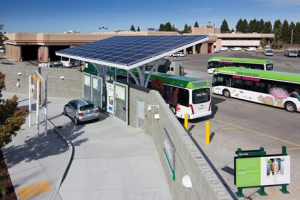DOT Puts Up $25 Million for Zero Emission Buses
 The U.S. Department of Transportation’s Federal Transit Administration (FTA) is making $24.9 million available through its brand new Low or No Emission Vehicle Deployment Program (LoNo). The goal is to put a new generation of advanced, non-polluting transit buses on the road in communities nationwide.
The U.S. Department of Transportation’s Federal Transit Administration (FTA) is making $24.9 million available through its brand new Low or No Emission Vehicle Deployment Program (LoNo). The goal is to put a new generation of advanced, non-polluting transit buses on the road in communities nationwide.
The funds are intended to encourage more widespread adoption of reliable “green energy” buses into transit fleets.
“The LoNo program will make a real difference in people’s lives by helping them get to work or school while letting them breathe clean air,” said Transportation Secretary Anthony Foxx.
The FTA’s Low or No Emission Vehicle Deployment Program was established under the Moving Ahead for Progress in the 21st Century Act (MAP-21). It focuses on commercializing the cleanest and most energy-efficient U.S.-made transit buses to help reduce emissions like carbon dioxide and carbon monoxide.
The LoNo program builds on the success of FTA’s National Fuel Cell Bus Program, which invested in the research, development and testing of alternative fuels and related equipment, such as electric charging stations, for the transit industry. This program, according to the agency, has “successfully committed $90 million over seven years for innovative research, demonstration, and deployment projects to reduce the cost of fuel cells for transit use.” The program received its final funding in FY2013.
“Federal investments in green energy and related technologies have been a tremendous catalyst for America’s innovators and domestic manufacturers as they find new ways to power public transportation for the future,” said FTA Administrator Peter Rogoff. “We are excited to help improve the transit riders’ experience by bringing more of the cleanest and greenest buses available to their cities and towns—and to spur new jobs in a growing industry.”
FTA will award the LoNo funds on a competitive basis to transit agencies and state transportation departments working either independently or jointly with bus manufacturers already making low- and zero-emission buses. Priority will be given to proposals that:
- Seek to fund the incremental difference between a standard bus and a LoNo vehicle, as a way to stretch procurement dollars farther;
- Incorporate the highest level of U.S.-made content, exceeding Buy America’s current 60 percent threshold; and
- Demonstrate a long-term commitment to expanding LoNo fleets beyond what these program funds support, including the use of Federal formula funding.
Of the $24.9 million available in LoNo grant funds, $21.6 million is for buses and $3.3 million to support facilities and related equipment. Transit agencies may use a portion of their annual FTA formula funds to purchase additional vehicles.
In addition to their environmental benefits, LoNo transit buses will, in the long run, according to the agency, “help transit agencies save money on fuel and maintenance costs.” According to the National Renewable Energy Laboratory, zero-emission buses can achieve more than double the fuel economy of buses running on diesel and other fuels.
Category: General Update, Green, Transit News










